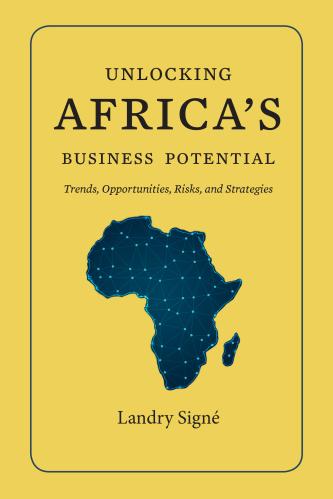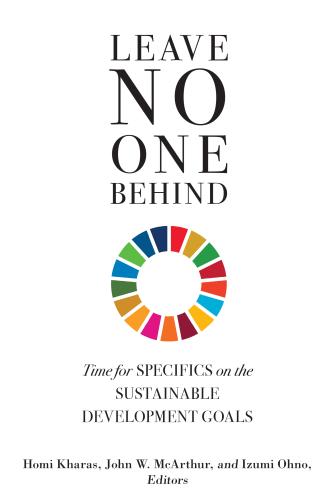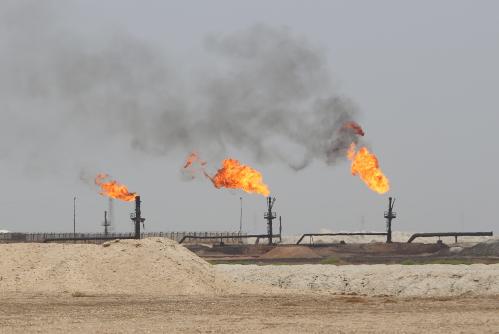The question of how natural resources affect economic development is an important and intriguing field of economic research. Although the early resource curse literature documented a strong negative relationship between natural resources and GDP growth, a growing body of contradicting evidence has emerged. With many countries still highly dependent on volatile resource rents, how natural resources affect development remains a high-stakes policy question.
One major reason for the lack of consensus on how resources affect development is that more than one explanation might be true at the same time. Figure 1 identifies two important channels: a direct economic effect and an indirect institutional effect. The direct effect includes several economic factors with both positive and negative components. On the positive side, natural resources generate economic rents that can be used for public good provision and other productive purposes. In the long-term, however, uncertainties associated with declining and volatile terms of trade for commodities can undermine public finance and discourage investment. The latest oil price crash that triggered fiscal crisis in major petroleum-producing countries like Russia, Nigeria, and Saudi Arabia is one example of this negative effect. The cumulative direct effect of resources on long-term development can thus be either positive or negative, depending on the balance between these offsetting effects.
The indirect effect of natural resources on development comes from the potential adverse effects of resources on institutional quality. Political scientists and economists have long argued that resource wealth undermines the development of political and governance institutions by fostering a rentier institutional culture. For example, resource revenues can be used for political control through patronage spending and investments in security apparatuses. Further, resource windfalls can weaken government accountability toward citizens and businesses by decoupling taxation from expenditure. Lacking the need for tax revenues, governments will have little incentive to introduce pro-growth reforms, while citizens will lack the incentive to demand improved governance and accountability.
The overall effect of natural resources on development will, therefore, depend on the magnitude of these two separate effects.

Our recently published study provides a detailed and nuanced answer to the question posed in the title: whether natural resources help or hinder long-term development. Using a global sample of more than 100 countries, we relate natural resource wealth in the commodity supercycle of the 1970s to subsequent performance in human and physical capital development. The analysis jointly explains institutional quality and development outcomes in a cross-country setup using the three-stage least squares (3SLS) instrumental variable estimation method.
Three important findings emerge from our empirical examination, which help reconcile seemingly contradictory findings in the resource curse literature.
Finding 1. Natural resources generally have a positive direct effect through the economic channel and a negative indirect effect through the institutional channel.
Countries that start with high levels of natural resources in the late 1970s subsequently achieve significantly higher levels of human development, human capital accumulation, tertiary school enrollment, and public capital per person, given their initial levels of income and institutional quality. Despite volatile commodity prices, natural resource rents thus seem to advance economic development.
The negative indirect effect shows that, over the long term, natural resources undermine the development of institutions. Since institutions are major determinants of economic development, the deleterious effect of resources on institutional quality translates into a significant adverse effect on development performance.
The total effect, which results from summing up these two effects, generally becomes zero although this depends on the specific development outcome as indicated below. The positive economic effect is hence offset by the negative institutional effect. This result highlights why studies that look at only one of these two channels can provide an incomplete, and thus potentially misleading, answers on the relationship between resources and development.
Finding 2. Natural resource dependence rather than natural resource abundance undermines institutional development.
To underscore the importance of the distinction between resource abundance and resource dependence, let’s consider the examples of Canada and the Republic of Congo. According to World Bank data, the two countries have the same levels of natural resource endowment, with resource rents per capita of around $1,200 as of 2013. The contribution of resources to GDP, however, was much larger in Congo (42.3 percent) than in Canada (2.3 percent). While both countries can be considered resource abundant, only Congo can be said to be truly dependent on resources.
Our results indicate that, other things constant, the negative effect of resources on institutions is more pronounced in countries like Congo. This is intuitive since the political economic mechanisms through which resources undermine institutional change is likely to be weakened when countries have diversified economies. Economic elites in non-resource sectors could push for reforms that benefit the broader economy, thus counterbalancing resource lobbies that resist institutional reform to create conditions that favor rent-capture. In less diversified economies, on the other hand, resource rents strengthen the power of the state, beefing up its capacity for political control through redistributive policies and high investments in security apparatuses.
This result reveals why studies that use resource dependence and abundance as alternative measures of resources tend to report different results. Given initial income levels, countries that start off with greater resource dependence will end up with relatively lower institutional quality, while this is not necessarily the case for countries that start with high levels of resource abundance. The indirect negative effect through institutions, therefore, is larger and negative for resource dependence. Between the two measures, we also find that resource abundance leads to a more consistent direct positive effect on development outcomes.
Finding 3. The effect of resources on development tends to differ between physical and human capital development outcomes.
Our analysis suggests that human development outcomes appear to suffer more from the negative indirect channel of the resource curse than physical capital. On the other hand, GDP per capita and physical capital development appear to benefit relatively more from the direct economic effects of resource booms. This may be because resource rents can lift incomes and provide hard currency for financing investment projects. This result, however, should be interpreted with caution since the measurement of public capital might also pick up public expenditures designed to facilitate resource extraction.
Summary
The results show that natural resources are best seen as a double-edged sword that has a positive economic effect as well as a negative institutional effect on development performance. The balance between the two appears to depend on the way natural resources are measured—abundance or dependence—and the specific type of development outcome considered: human or physical. While our results identify potential explanations for the contradictory findings across prior research, more evidence is needed to further understand the complex linkage between resources and development, and shed light on how countries can minimize the risk of the resource curse.
The Brookings Institution is committed to quality, independence, and impact.
We are supported by a diverse array of funders. In line with our values and policies, each Brookings publication represents the sole views of its author(s).











Commentary
Are natural resources a curse, a blessing, or a double-edged sword?
July 16, 2020